By Dorothy Koppelman
Magnificently, in the paintings of Joseph Mallord William Turner, there is a light so blazing and so deep, one can almost be completely absorbed—and always, too, there is that blackness. I am exploring the meaning of those opposites—Light and Dark, central not only in the work, but in the life, the very self of the artist. My critical basis is this principle stated by poet and critic Eli Siegel, founder of the education Aesthetic Realism: “The resolution of conflict in self is like the making one of opposites in art.”
I think there is nothing more beautiful in this world than the relation of opposites as Aesthetic Realism sees and describes it in the very structure and substance of all things. It is that relation of opposites, subtle, changing, always new and yet abiding as time, that art presents. However, in the history of art, there has never before been a means of having the lives of the artists deeply coherent with their work. There has never been, before Aesthetic Realism, any idea that a man’s life could be like the art he makes. When Eli Siegel founded Aesthetic Realism in 1941, he gave all people, and certainly all artists, a way of having the beautiful logic of art become as well the happy logic of our lives.
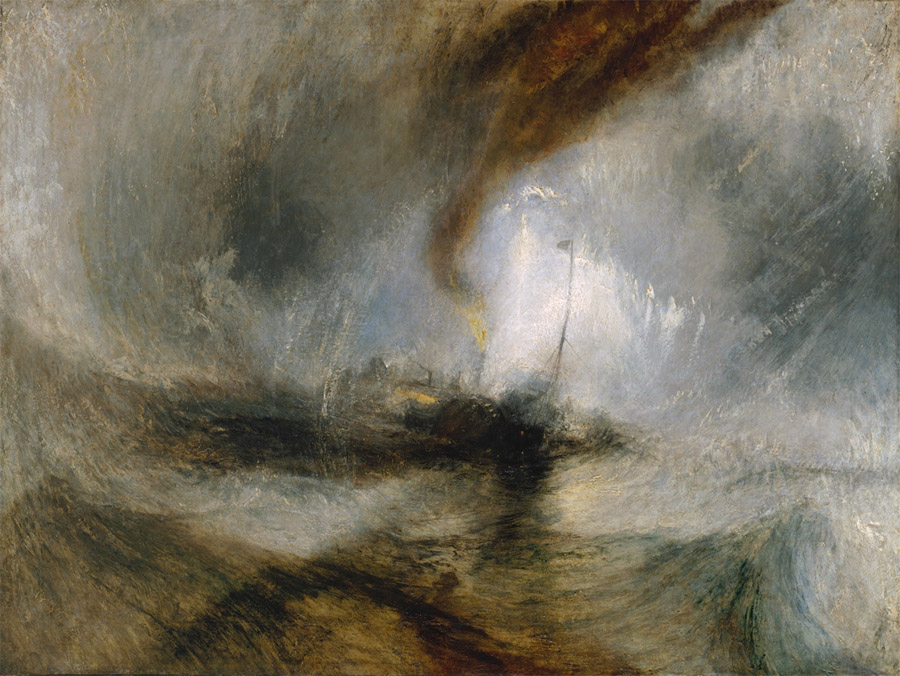
1. The Luminous and Hidden
Opposites as beginning as any for the visual arts are Light and Dark. We couldn’t see without light and no painter ever saw light on an object without also seeing shadow or dark. One of Eli Siegel’s Fifteen Questions in the great 1955 publication Is Beauty the Making One of Opposites? is about Light and Dark:
DOES all art present the world as visible, luminous, going forth?—and does art, too, present the world as dark, hidden, having a meaning which seems to be beyond ordinary perception? —and is the technical problem of light and dark in painting related to the reality question of the luminous and hidden?
The “reality question of the luminous and hidden” is crucial in the work and life of Joseph Mallord William Turner, the great English painter who lived from 1775 to 1851. Turner had a passion for light and the light he loved was turbulent, churning, always in motion. He studied light and painted it with intensity in relation to floods, storms, fog, steam, snow, and to what critics have described as “cataclysmic, or elemental events.” This is Turner’s Fighting Temeraire, the greatest painting— “without a parallel in art,” said Ruskin”—by the greatest of English painters:
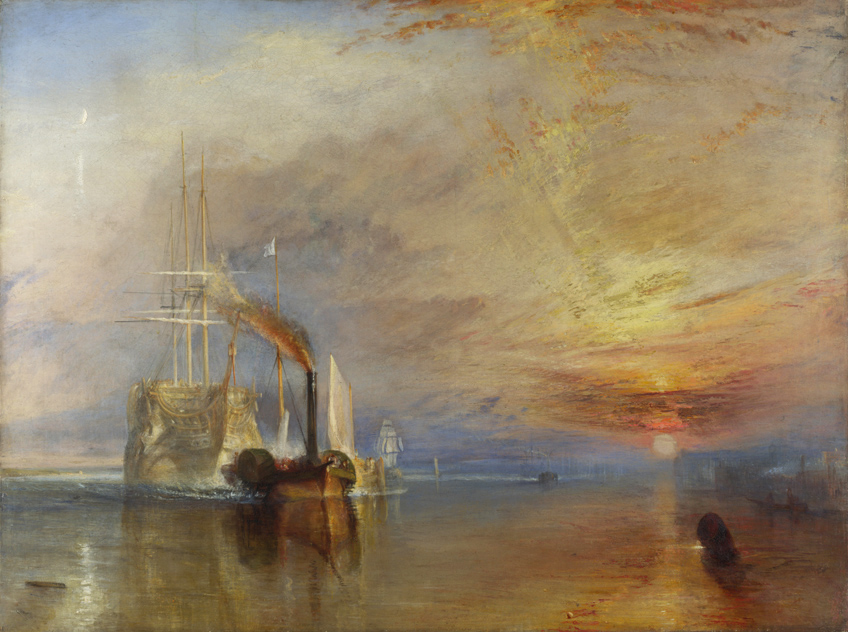
William Makepeace Thackeray writes of it:
The old Temeraire is dragged to her last home by a little, spiteful, diabolical steamer. A mighty red sun amidst a host of flaring clouds, sinks to rest on one side of the picture, and illumines a river that seems interminable. The little demon of a steamer is belching out a volume of…foul, lurid, red-hot malignant smoke; paddling furiously, and lashing up the water round about it….
Here, with its grand shape, thin masts and luminous color combining somehow bride, dowager and ghost, a British “ship of the line” is being towed to her end by that dark yet energetic little steamer. On the right the sun sets and spreads its light on the water to include the bulky silhouette of dark wood in the foreground. And too, within the setting sun is the round, cool moon.
As artist, Turner was driven by his desire to see, his tremendous love for light and what it could do; but in his life he was too much driven by his desire to hide, to be in the dark. The way light and dark are in his work is breathtaking; the way these opposites quarrel in his life is monumentally painful and sad.
Listen to this description of the man who painted that blazing and yet sad light —a light that includes and is enhanced by the presence of darkness—by E.V. Lucas in his British Pictures and Their Painters:
The life of Turner illustrates better almost than that of any man how little correspondence can on occasion exist between beauty and the maker of beauty. Turner’s works are marvels of a loveliness and grandeur; Turner was miserly and squalid….He saw visions and glorified even what was already glorious; and he deliberately chose to live in houses thick with grime.
Stories are told of Turner’s secretiveness, of how he didn’t want to be watched, or “spied on” when he worked, how he guarded his secrets from other artists; Turner was gruff, he cowed his fellow artists—Constable for example—and other people, not knowing him, called him “the dusty little man with a pencil.”
But along with Turner’s apparent miserliness, there was generosity. At his death he willed a large part of his very large fortune to found a home for indigent artists; money which his grasping relatives managed to get instead. And, although he quarreled with other artists, and was competitive, he once told his most ardent admirer and defender, John Ruskin, that the critic did not understand what hard work it was to make even a mediocre painting.
This is called Peace—Burial at Sea, a memorial to David Wilkie, an artist with whom Turner had once quarreled about the technical questions of light and dark and the merits of using black in painting.

Critics have praised this painting and they have also said that the black sails were Turner’s final technical and sly triumph over Wilkie; but I believe the way black sails, black smoke, black reflections work together in this painting, along with warm and cool blue water, white and blue sky, have in them pride and a genuine melancholy at once. I think this painting shows that Turner wanted his generosity and his stinginess, his arrogance and his secretiveness to work together for one purpose. He was trying to take the quarrels of his life and change them into the composition of art. I have sometimes come to tears in reading about his life because the great painter did not know, could not have known, that the composition of his art had in it what could have made his life more peaceful. For me, looking at the life and work of Joseph Turner has been like finding a new continent; and every aspect of it is testimony of the truth and the need for Aesthetic Realism.
2. Finding Form in Ugliness and Chaos
This is one of the paintings that made me feel close to him: The Slave Ship; it illustrates a terrible event that affected Turner as a boy. An unscrupulous slave trader, for financial reasons, threw all the diseased and dying slaves off his boat even though he knew that assistance for them might be had.
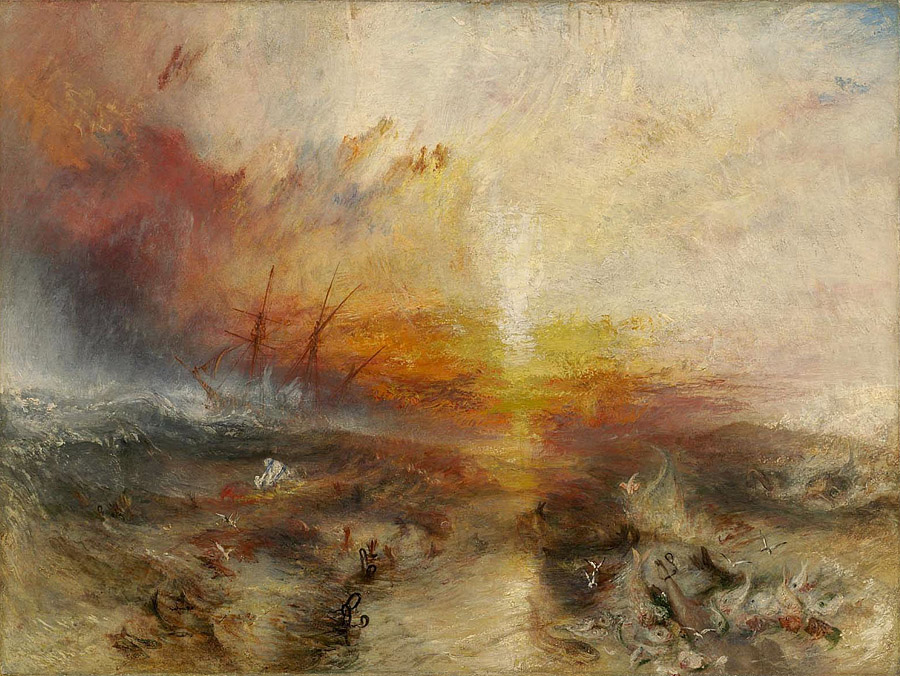
I think in his depiction of this event, Turner also gives powerful form to the ugliest thing in himself and in every person, the desire to have contempt—to be superior and lessen, even annihilate other people and things—which Aesthetic Realism explains is the cause of all injustice and human cruelty. Through looking at this contempt honestly, critically here, I think Turner simultaneously got to something ecstatic—freedom—through that light. The boat, which the artist saw as like himself, is freed of burden and lifted high in the water in a feeling of release; a release which occurs at the same time, and as I see it, because those dark, turbulent, embroiled figures which the artist saw also as an aspect of himself are illuminated in the foreground sinking into the water. The combination of the submerged and the yearning, soaring Turner is presented to view. And that vertical blaze of light joins the two sides of the painting for all to see in a brilliant composition.
Jack Lindsay, in his work on Turner, quotes Ruskin on the painter’s purpose:
Turner was never afraid of bringing dingy oddments into his works, “smoke, soot, dust, and dusty texture; old sides of boats, weedy roadside vegetation, dunghills, straw-yards, and all the soilings and stains of every common labour. And more than this, he could not only endure, but enjoyed and looked for litter, like Covent Garden wreck after the market. . .he delights in shingle, debris, and heaps of fallen stone. The last words he ever spoke to me about a picture were in gentle exultation about…’that litter of stones which I endeavored to represent.'”
When I read that I thought, “I understand. I think that as artist Turner had to find form in chaos, he had to see light in debris, find, as Eli Siegel once described it, ‘God amidst the garbage.'”
But, as person, Joseph Mallord William Turner, like many artists, used the evil in people, the ugliness he saw to say the world was a place to hide from and be superior to. I think the questions Mr. Siegel asked me in Aesthetic Realism lessons about my desire to hide and my desire to see are questions Turner was yearning to hear.
3. Shame and Triumph in the Open
In an Aesthetic Realism Art Inquiry of 1967, those lessons in which Eli Siegel taught me what my deepest intention as a person and an artist is, and for which I will be grateful for the rest of my life, this painting, Landscape of Rats and Garlic, was discussed:

I described the painting this way: “the thing that took me so much was that the shape of the white garlic and the grey rats are the same, but a rat can want to go in, to vanish speedily, and the garlic with that smell, obviously comes forward, and I wanted to have them cast up by the sea, in the open, under the sky.”
Mr. Siegel asked me: “What do you think of garlic? It happens,” he said,” that many persons who like to recede deeply are fond of spicy things. Would you say your love for garlic was in the whole world, for the whole world?— Is it sunny or is it furtive?” And Mr. Siegel asked me what I wanted in my life, “What are you for—gusto or recession? What is your message in this painting?”
Mr. Siegel saw what I wanted; “to show,” he said, “both shame and triumph in the open; to study pride and disorderliness.” Through questions such as these I have been able better to distinguish between the two desires that fight in all people: the desire to have contempt for things and to vanish; and the desire to see them with form.
In Aesthetic Realism consultations now, because we ourselves have been asked the liberating Aesthetic Realism questions we can gratefully ask about the “reality question of the luminous and the hidden” in a person’s life, as Eli Siegel describes it in Is Beauty the Making One of Opposites? The pleasure of seeing opposites as one, in being asked questions so that one can see this, is the only rival to contempt; it can also lift the burden of shame. We know this for ourselves; and we have seen it happen.
Turner, in his life, was too furtive and he succumbed to contempt, darkness too much. Towards the end of his life he even secretly left one home in London to live in Chelsea with a Mrs. Booth; and he, the great Turner, to keep off prying, was content to be known to the boys in the street as Puggy Booth. At the same time he was hiring a boy to row him on the river Thames so he could be in a storm, study its changes. What he saw on the Thames was a light that made the terrors of darkness beautiful.
This is Keelmen Heaving in Coals by Moonlight:
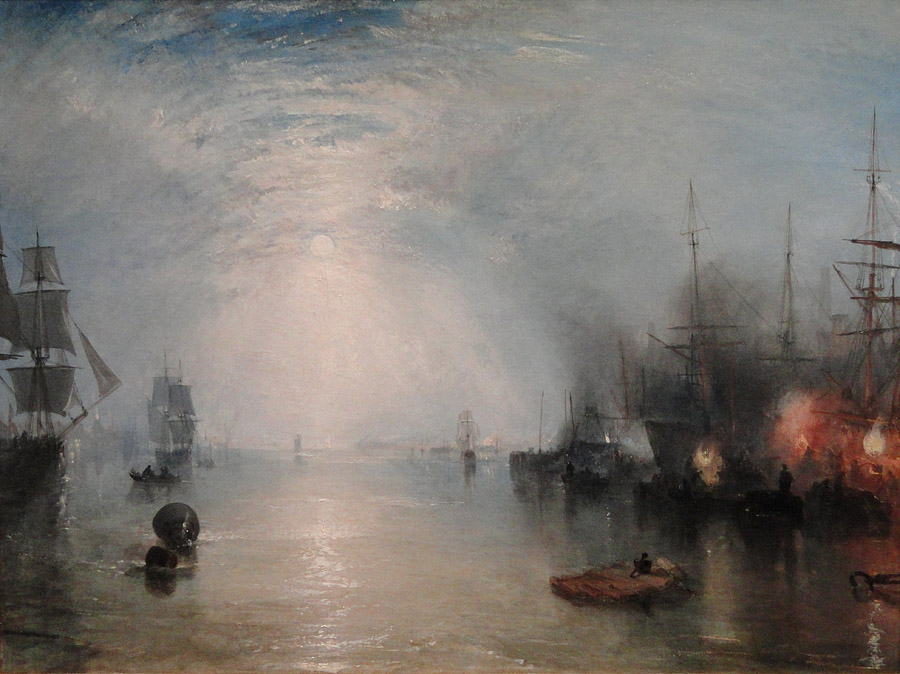
Dark and light do not merge into one another in this painting, they confront one another and we confront them. There is a simultaneity of utter, blazing, almost unlookable at light and black: black on the right, with touches of a fiery red, and black masts, black ships on the left, and a black buoy in the yellow water. That conflict which Turner’s life had in it so uncomposed, a conflict between unconfined love and constricting contempt is here resolved in a blazing ecstasy.
It is paintings like these that caused Cosmo Monkhouse to say “that as Turner grew older he robbed Nature of her darkness and Earth of her weight.”
This is The Dogana and Santa Maria della Salute done in Venice about 1843 eight years before Turner died in December of 1851. Constable, the English landscape painter said of these Venice paintings: “They are…visions—only visions, but still one would like to live and die with such pictures.” That is true.
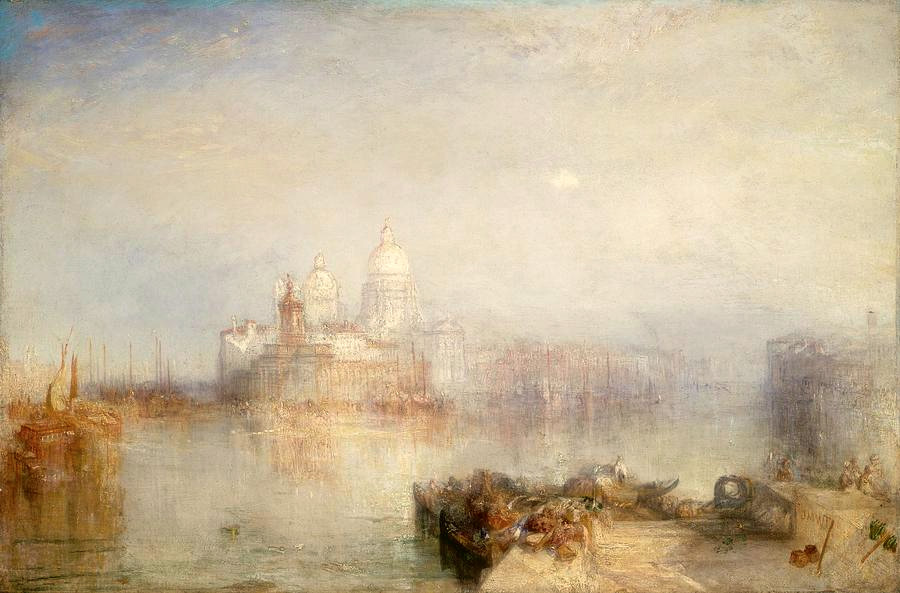
One sees something like heaven, with that angel whiteness and breadth of blue, light sky. But in the foreground there are the “dingy oddments,” the inner life, the “pain,” Ruskin writes about. The great message of all those magnificent paintings is—light and litter are in the same world. It is a message that means a great deal to me and it affirms Eli Siegel’s Aesthetic Realism principle: “In reality opposites are one; art show this.”
♦ This talk was reprinted in ASCA Newsletter #54 Winter-Spring 2015.
♦ “Turner’s Modern World” at the Museum of Fine Arts, Boston, March 2–